 |
 |
 |
 |
 |
 |
| |
 |
|
 |
 |
 |
  |
  |
 |
 |
 |
 |
|
 |
|
 |
 |
 |
AWARDS |
 |
|  |
|
 |
 |
 |
|
|
 |
Alvar Aalto Medal
Museum of Finnish Architecture - Finnish Association of Architects (SAFA) |
|
|
|
 |
AIA Gold Medal
The American Institute of Architects |
|
|
|
 |
Sonning Prize
Københavns Universitet (University of Copenhagen) |
|
|
|
 |
Royal Gold Medal
RIBA - Royal Institute of British Architects |
|
 |
 |
 |
BUILDINGS |
 |
|
 |
|
 |
 |
 |
|
|
 |
|
|
  Finland [Suomi/Finland]
Finland [Suomi/Finland]
» Rovaniemi |
|
|
|
|
 |
|
|
|
 |
|
|
  Finland [Suomi/Finland]
Finland [Suomi/Finland]
» Seinäjoki |
|
|
|
|
 |
|
|
  Finland [Suomi/Finland]
Finland [Suomi/Finland]
» Jyväskylä |
|
|
|
|
 |
|
|
|
 |
|
|
|
 |
|
|
  Finland [Suomi/Finland]
Finland [Suomi/Finland]
» Jyväskylä |
|
|
|
|
 |
|
|
|
 |
|
|
  Switzerland [Schweiz/Suisse]
Switzerland [Schweiz/Suisse]
» Horw |
|
|
|
|
 |
|
|
|
 |
|
|
|
 |
|
|
  Finland [Suomi/Finland]
Finland [Suomi/Finland]
» Seinäjoki |
|
|
|
|
 |
|
|
  Germany [Deutschland]
Germany [Deutschland]
» Bremen |
|
|
|
|
 |
|
|
  Germany [Deutschland]
Germany [Deutschland]
» Wolfsburg |
|
|
|
|
 |
|
|
  Finland [Suomi/Finland]
Finland [Suomi/Finland]
» Seinäjoki |
|
|
|
|
 |
|
|
  Finland [Suomi/Finland]
Finland [Suomi/Finland]
» Helsinki [Helsinki/Helsingfors] |
|
|
|
|
 |
|
|
  Finland [Suomi/Finland]
Finland [Suomi/Finland]
» Imatra |
|
|
|
|
 |
|
|
  Germany [Deutschland]
Germany [Deutschland]
» Berlin |
|
|
|
|
 |
|
|
  Finland [Suomi/Finland]
Finland [Suomi/Finland]
» Jyväskylä |
|
|
|
|
 |
|
|
|
 |
|
|
  Finland [Suomi/Finland]
Finland [Suomi/Finland]
» Espoo [Espoo/Esbo] |
|
|
|
|
 |
|
|
  United States
United States
» Cambridge |
|
|
|
|
 |
|
|
  Finland [Suomi/Finland]
Finland [Suomi/Finland]
» Noormarkku |
|
|
|
|
 |
|
|
  Russia [Rossija]
Russia [Rossija]
» Vyborg |
|
|
|
|
 |
|
|
  Finland [Suomi/Finland]
Finland [Suomi/Finland]
» Paimio |
|
|
|
|
 |
|
|
  Finland [Suomi/Finland]
Finland [Suomi/Finland]
» Jyväskylä |
|
|
|
|
 |
|
|
  Finland [Suomi/Finland]
Finland [Suomi/Finland]
» Jyväskylä |
|
|
 |
 |
 |
 |
BIBLIOGRAPHY |
 |
|
|
 |
|
 |
 |
 |
WRITINGS
BY THE ARCHITECT |
 |
|
|
 |
 Alvar Aalto, Ilmo Kalkas, Severi Savonen, (ed.), Varsinais-Suomen Tuberkuloosiparantola, 1950 Alvar Aalto, Ilmo Kalkas, Severi Savonen, (ed.), Varsinais-Suomen Tuberkuloosiparantola, 1950 |
|
|
|
 |
 |
 |
WRITINGS
ABOUT THE ARCHITECT |
 |
|
|
 |
| Céline Dietzkier, Lukas Gruntz, Aalto in Detail. A Catalogue of Components, Birkhäuser, Basel 2022 |
|
|
| Jochen Eisenbrand, Mateo Kries, Alvar Aalto. Second Nature, Vitra Desogn Museum, 2014 |
|
|
 Eeva-Liisa Pelkonen, Alvar Aalto. Architecture, Modernity, and Geopolitics, Yale University Press, New Haven/London 2009 Eeva-Liisa Pelkonen, Alvar Aalto. Architecture, Modernity, and Geopolitics, Yale University Press, New Haven/London 2009 |
|
|
| Sandra Dachs, Patricia de Muga, Laura García Hintze (ed.), Alvar Aalto. Objekt- und Möbeldesign, DuMont, Köln 2007 |
|
|
| Kenneth Frampton, Marc Treib, Alvar Aalto. 1898-1976, Mondadori Electa, 2007 |
|
|
| Louna Lahti, Aalto, Taschen, 2005 |
|
|
| Francesca Prina, Elena Demartini, Grande Atlante dell'Architettura dal Mille al Duemila, Mondadori Electa, Milano 2005, pp. 320-321 |
|
|
AA.VV., Alvar Aalto Designer, Alvar Aalto Foundation, Alvar Aalto Museum, Jyväskylä 2002
review: Silvia Monaco, "Il designer che venne dal freddo/The designer who came in from the cold", Domus 856. febbraio/february 2003, "Libri/Books" pp. 7-9
|
|
|
| Roger Connah, Aaltomania. Readings against Aalto?, Building Information LTD, Helsinki 2000 |
|
|
| Jürgen Tietz, Storia dell'architettura del XX secolo, Könemann Verlagsgesellschaft mbH, Milano 2000, p. 72 |
|
|
| Kari Jormakka, Jacqueline Gargus, Douglas Graf, The Use and Abuse of Paper. Essays on Alvar Aalto, Datutop 20, Tampere 1999 |
|
|
| Göran Schildt, Alvar Aalto. Capolavori, Rizzoli, 1998 |
|
|
| Kenneth Frampton, "Retrospettiva di Alvar Aalto: sei punti focali per il prossimo millennio/Aalto in retrospect: six foci for the next millennium", Domus 801, febbraio/february 1998 [Materiali/Materials], pp. 49-56 |
|
|
 Peter Reed (ed.), Alvar Aalto. 1898-1976, Electa, Milano 1998 Peter Reed (ed.), Alvar Aalto. 1898-1976, Electa, Milano 1998 |
|
|
| Göran Schildt (ed.), Aalto, Alvar. Alvar Aalto in His Own Words, Rizzoli, New York 1998 |
|
|
| Peter Reed (ed.), Alvar Aalto. Between humanism and materialism, Museum of Modern Art/H.N. Abrams, New York 1998 |
|
|
| Aarno Ruusuvuori (ed.), Alvar Aalto. 1898-1976, Museum of Finnish Architecture, Helsinki 1998 |
|
|
| Paolo Angeletti, Maria Gaia Remiddi, Alvar Aalto e il Classicismo Nordico, Croma Quaderni 8, Roma 1998 |
|
|
| Alvar Aalto, Rizzoli, 1998 |
|
|
| Ásdís Ólafsdóttir, Le Mobilier D`Alvar Aalto dans L'espace et dans le Temps, Publications de la Sorbonne, Paris 1998 |
|
|
| Michael Trencher, The Alvar Aalto Guide, Princeton Architectural Press, 1996 |
|
|
| Richard Weston, Alvar Aalto, Phaidon, London 1995 |
|
|
| Göran Schildt, Alvar Aalto. The Complete Catalogue of Architecture, Art and Design, Rizzoli International, New York 1994 |
|
|
| Göran Schildt (ed.), Aalto, Alvar. The Architectural Drawings of Alvar Aalto, 1917-1939, (11 volumes), Garland Pub., New York, 1994 |
|
|
| Göran Schildt, Alvar Aalto. The Mature Years, Rizzoli, New York 1991 |
|
|
| Luigi Spinelli (ed.), "Aalto/Marsio e il classicismo nordico" Itinerario 63, Domus 722, dicembre/december 1990 |
|
|
| Vittorio Locatelli, "Alvar Aalto, il Baltico e il Mediterraneo", Domus 722, dicembre/december 1990, pp. 80-84 |
|
|
| Sergio Crotti, "Alle origini di Alvar Aalto: tradizione baltica e clima mediterraneo", Casabella 571, settembre/september 1990, pp. 24-25 |
|
|
| AA.VV., Alvar Aalto. Il Baltico e il Mediterraneo, Marsilio, Venezia 1990 |
|
|
| Göran Schildt, Alvar Aalto. The Decisive Years, Rizzoli International, New York 1988 |
|
|
| Göran Schildt, Alvar Aalto. The Early Years, Rizzoli, New York 1984 |
|
|
| Juhani Pallasmaa (ed.), Alvar Aalto Furniture, Museum of Finnish Architecture, Helsinki 1984 |
|
|
| Malcolm Quantrill, Alvar Aalto. A Critical Study, New Amsterdam, New York 1983 |
|
|
| Graziano Campisano, Alvar Aalto, Editrice Clear, 1983 |
|
|
| Paolo Angeletti, Carmine Benincasa, Anna Giacomelli, Gaia Remiddi (ed.), Alvar Aalto, Leader Arte Cataloghi, Roma 1983 |
|
|
 Leonardo Mosso, Alvar Aalto, Studioforma Editore, Torino 1981 Leonardo Mosso, Alvar Aalto, Studioforma Editore, Torino 1981 |
|
|
 Luciano Rubino, Aino e Alvar Aalto. Tutto il design, Edizioni Kappa, Roma 1980 Luciano Rubino, Aino e Alvar Aalto. Tutto il design, Edizioni Kappa, Roma 1980 |
|
|
| Carlo Cresti, Alvar Aalto, Sansoni Editore, Firenze 1978 |
|
|
| David Dunster (ed.), Alvar Aalto, St. Martin's Press, London 1978 |
|
|
| Leonardo Mosso, "Alvar Aalto. Internazionalismo e tradizione/Internationalism and tradition", Casabella 415-416, luglio-agosto/july-august 1976, pp. 30-39 |
|
|
Karl Fleig (ed.), Alvar Aalto, Praeger Publishers, New York 1974
tr.it.: Zanichelli, Bologna 1986 |
|
|
Frederick Albert Gutheim, Alvar Aalto, George Braziller, New York 1960
tr.it.: Il Saggiatore, "I maestri dell'architettura contemporanea", Milano 1960 |
|
|
| Giorgio Labò, Alvar Aalto, Il Balcone, "Architetti del moviemnto moderno", Milano 1948 |
|
 |
 |
 |
 |
THE ARCHITECT IN CINEMA |
 |
|
|
 |
|
 |
 |
 |
| Title |
 |
|
 |
|
| Directed by |
 |
|
 |
|
| Nationality |
 |
|
 |
|
| Year of production |
 |
|
 |
|
| Cast |
 |
|
 |
|
| Architect's role |
 |
|
 |
Protagonist
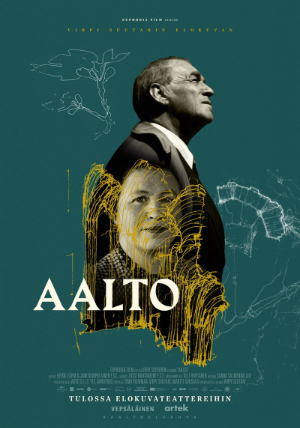 |
|
 |
 |
 |
|
 |
|
| Title |
 |
|
 |
|
| Directed by |
 |
|
 |
|
| Nationality |
 |
|
 |
|
| Year of production |
 |
|
 |
|
| Cast |
 |
|
 |
| Charles Arnoldi, Mildred Friedman, Frank O. Gehry, Bob Geldof, Dennis Hopper, Charles Jencks, Philip Johnson, Sydney Pollack |
|
| Architect's role |
 |
|
 |
|
 |
 |
 |
 |
 |
 |
 |
EXHIBITIONS |
 |
|
|
 |
|
 |
 |
 |
|
|
 |
|
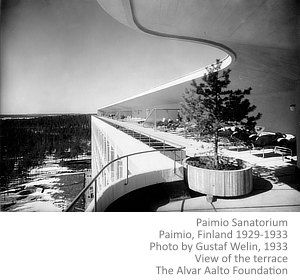 “True architecture only exists when it is centred around human beings.”
For Alvar Aalto, Aino Marsio and Elissa Mäkiniemi, this statement was the starting point for the creation of a revolutionary concept of architecture destined to leave an indelible mark on Europe and the world.
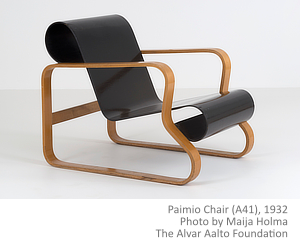 The exhibition AALTO – Aino Alvar Elissa. The Human Dimension of Design, curated by Space Caviar and to be hosted at the MAXXI National Museum of 21st -Century Arts as of 14 December 2023, testifies to the studio’s unwavering commitment to placing the human experience at the centre of its vision.
A common thread links different projects and fields of research: from workers’ clubs to town halls, from single-family homes to housing estates, from objects and furniture designed for everyday life to works with glass, textiles, lighting and children’s furniture.
All of the above testifies to an idea of architecture and design that is conceived for people, welcoming and functional, in balance with the environment and characterised by unmistakable fluid, undulating lines (in Finnish, aalto means precisely wave).
Founded in Finland in 1923, Studio Aalto was established at a time of rapid and turbulent change, when the country was building its new identity as a free nation.
Architect Aino Marsio, Alvar’s first wife, was fundamental in shaping the design philosophy of the studio in the early years. Their partnership would give rise to some of the studio’s most famous projects, such as the Sanatorium of Paimio.
In 1952, three years after Aino’s untimely death, Alvar married Elissa Mäkiniemi, also an architect, initiating a new, fervent creative collaboration that would lead to an international opening unprecedented in the history of Finnish architecture.
The exhibition at MAXXI encompasses five decades of Studio Aalto’s work, as recounted through a selection of eleven of its most significant projects, realised from the 1920s to the early 1980s: the Muuratsalo Experimental House in Finland (1952-1954), a summer residence whose façades are the result of the composition of different types of bricks and ceramics, which inspired the set-up project conceived by the Space Caviar studio itself; the Jyväskylä Workers’ Club, Finland (1924-1925), the first major public building designed by the studio; the Civic Library of Vyborg, which at the time of its construction (1927-1935) was still part of Finland rather than Russia; the Town Hall of Säynätsalo, Finland (1949-1952), a building with a unique character, opening up to the citizens with its human-scale environments; the Mount Angel Abbey Library in St. Benedict, Oregon – USA (1949-1925), which is perched on a mountain slope and was redesigned to save two majestic fir trees; Villa Mairea in Noormarkku, Finland (1937-1939) one of the symbolic buildings of 20th -century architecture, also represented in the exhibition by a 1:1 scale reconstruction of the iconic kidney pool; The National Pensions Institute in Helsinki (1948-1957), a complex comprised of several volumes connected to each other both above and below ground; the Church and parish centre in Riola di Vergato, Italy (1966-1980), a posthumously-built project with a complex history that testifies to Aalto’s special, often-reiterated bond with Italy; the MIT dormitories in Cambridge, Massachusetts – USA (1947-1949), capable of accommodating 353 students in 43 rooms of different shapes; the Sanatorium in Paimio, Finland (1929- 1933), a building that would gain the firm international fame, conceived as a medical instrument capable of contributing to the healing of patients; the industrial and residential area in Sunila, a district of the port city of Kotka, Finland, for which Aalto designed the master plan, a paper mill and housing for all the factory workers at different times, from 1936 to 1954.
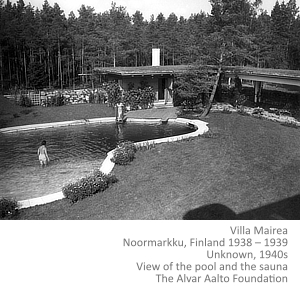 Five in-depth studies are then dedicated to as many areas of the studio’s research and activity: the work with glass, textiles, lighting, children’s furniture and the pioneering company Artek, created by the Aaltos to skilfully tap into the vast potential of mass production in the furniture sector. Displayed in the reading room at the start of the exhibition are a selection of furniture pieces that have become true icons of modern design, such as the Paimio chair and Stool 60.
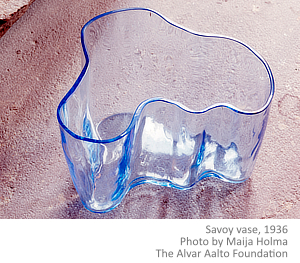 The exhibition is completed by the FPO (For Position Only) project by Ramak Fazel, who was invited by MAXXI to explore with his camera the architecture of Aino, Alvar and Elissa Alto and its impact on the current life of the communities, travelling between Italy, Finland and the United States.
Finally, there is the videogame Hide and Seek in Architecture, created by the Space Caviar studio on the occasion of the exhibition in collaboration with Meta – an immersive experience in the VR environment of Meta Quest that invites players to hide in the ingenious Experimental House in Muuratsalo. |
|
|
Alvar Aalto in Deutschland: Gezeichnete Moderne / Alvar Aalto in Germany: Drawing Modernism, Berlin (Germany), Tchoban Foundation. Museum für Architekturzeichnung / Museum for Architectural Drawing, 23 september 2023 / 14 january 2024
The exhibition "Alvar Aalto in Germany: Drawing Modernism" at the Museum for Architectural Drawing, presented in collaboration with the Alvar Aalto Foundation in Finland, sets on display over 70 original drawings by the renowned Finnish architects Alvar Aalto (1898-1976) and Elissa Aalto (1922-1994) and their practice.
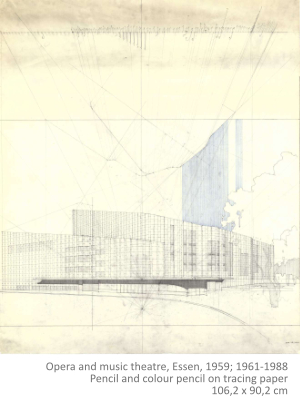 Spanning works from the 1950s, when Alvar Aalto was summoned to contribute to the vast (re)construction efforts that followed the Second World War, to the 1980s, when Elissa Aalto boldly brought to completion major projects that were left unfinished upon her husband's death in 1976, the exhibition features original drawings of the office's fourteen projects in Germany, both realised and unrealised. The six realised projects comprise three dyads: one pair each of churches, apartment blocks, and cultural buildings. The eight unrealised plans, in turn, encompass major public programmes — town halls, civic centres, master plans and commercial office buildings. Spanning works from the 1950s, when Alvar Aalto was summoned to contribute to the vast (re)construction efforts that followed the Second World War, to the 1980s, when Elissa Aalto boldly brought to completion major projects that were left unfinished upon her husband's death in 1976, the exhibition features original drawings of the office's fourteen projects in Germany, both realised and unrealised. The six realised projects comprise three dyads: one pair each of churches, apartment blocks, and cultural buildings. The eight unrealised plans, in turn, encompass major public programmes — town halls, civic centres, master plans and commercial office buildings.
The drawings presented in this exhibition chronicle the relationship which Alvar Aalto fostered with Germany and German architectural culture from his youth to his death, and which was cultivated further by Elissa Aalto. From the late 1940s and early 1950s onward, Alvar Aalto Architects Ltd. was heralded in Germany as a "humane" exception to an otherwise more mechanised doctrinaire modernism. The promise of the studio's purportedly softer genre of modernism was particularly auspicious in light of the horrors associated with mechanisation after the Second World War.
The exhibition presents the drawings neither chronologically nor project by project, but thematically. The first two themes address city-building. "Natural and Civic Topographies" explores how members of the Aalto studio sought to ensure that their German civic buildings and master plans grew organically from, and resonated with, their existing geographical and cultural contexts. "Projecting Identity" interrogates how architectural form and urban space were employed as tools of communicating a sense of local character to the world beyond, especially via massing and elevation.
The second two themes focus on specific architectural programs, and the challenges inherent in their design. "Boundaries of the Sacred" charts the ways in which Studio Aalto's two churches in Wolfsburg negotiate the relationship between the sacred and the profane, a tension interpreted especially in the design of walls, whereas "Humanising Standardisation" documents an effort to subjugate paradigms of efficiency and optimisation to human comfort in the domestic context.
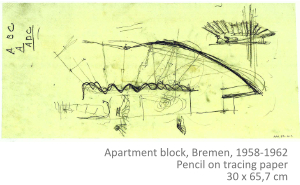 The drawings show that, for members of Studio Aalto, paper was the basic subsistence that kept alive the creative process. It was not art. The drawings are therefore beautiful but never self-consciously precious: their visual appeal is a by-product rather than end goal. The rambling, collaborative, spontaneous drawing process is best illustrated by early sketches for the various projects. As material traces of thinking, they are plainly and comprehensively honest, and dense. A calm counterpoint to the early untamed sketches is provided by carefully-drafted working drawings, which narrate the maturation of intuitive flurried ideas into delicate final designs. The drawings show that, for members of Studio Aalto, paper was the basic subsistence that kept alive the creative process. It was not art. The drawings are therefore beautiful but never self-consciously precious: their visual appeal is a by-product rather than end goal. The rambling, collaborative, spontaneous drawing process is best illustrated by early sketches for the various projects. As material traces of thinking, they are plainly and comprehensively honest, and dense. A calm counterpoint to the early untamed sketches is provided by carefully-drafted working drawings, which narrate the maturation of intuitive flurried ideas into delicate final designs. |
|
|
| Alvar Aalto (1898-1976). Architecte et designer finlandais, Paris, Cité de l'architecture et du patrimoine, 9 march / 1 july 2018 |
|
|
| Alvar Aalto. Art and the Modern Form, Helsinki (Finland), Ateneum, 11 may / 24 september 2017 |
|
|
| Suomalainen rivitalo. Työväenasunnosta keskiluokan unelmaksi / The Finnish rowhouse. From world-class housing to middle-class dream, Jyväskylä (Finland), Alvar Aalto -museon Galleria / Alvar Aalto Museum Gallery, 25 september / 15 november 2015 |
|
|
| La dolce vita. Alvar Aallon kesäparatiiseja / La dolce vita. Summer paradises by Alvar Aalto, Jyväskylä (Finland), Alvar Aalto -museon Galleria / Alvar Aalto Museum Gallery, 22 may / 20 september 2015 |
|
|
Alvar Aalto. Second Nature
Weil-am-Rhein, Germany, Vitra Design Museum, 27 september 2014 / 1 march 2015
Alvar Aalto. 1898-1976. Arquitectura orgánica, arte y diseño
Barcelona, Caixa Forum, 4 june / 23 august 2015
Madrid, Caixa Forum, 30 september 2015 / 10 january 2016 |
|
|
| Aallon arkkitehtuuria Rovaniemellä / Aalto’s architecture in Rovaniemi, Jyväskylä, Alvar Aalto -museon Galleria / Alvar Aalto Museum Gallery, 1 november 2013 / 2 february 2014 |
|
|
 Alvar Aalto Pavia 1966-1968, Pavia (Italy), Spazio per le Arti Contemporanee del Broletto, 21 september / 6 october 2013 Alvar Aalto Pavia 1966-1968, Pavia (Italy), Spazio per le Arti Contemporanee del Broletto, 21 september / 6 october 2013 |
|
|
| Jakkara tekee historiaa / Stool Makes History, Jyväskylä, Alvar Aalto -museon Galleria / Alvar Aalto Museum Gallery, 16 may / 8 september 2013 |
|
|
| Pienoismallit Alvar Aallon ateljeessa / Scale Models in Studio Aalto, Helsinki, Alvar Aallon ateljee / Studio Aalto, 24 april / 15 september 2013 |
|
|
| Jakkara 60. Stool 60 by Alvar Aalto, Helsinki, Studio Aalto, 13 march / 21 april 2013 |
|
|
| Alvar Aalto & Viljo Hirvonen & Valaistustyö Ky, Helsinki, Studio Aalto, 8 june / 31 december 2011 |
|
|
| Pariisin lasit. Aalto-maljakko 75 vuotta / Paris glass. The Aalto vase. 75 years on, Jyväskylä, Gallery, Alvar Aalto Museum, 12 may/2 october 2011 |
|
|
| Brilliance 24hr. Alvar Aalto & Viljo Hirvonen & Valaistustyö Ky, Jyväskylä, Gallery, Alvar Aalto Museum, 2 june/31 october 2010 |
|
|
| Aalto, Ervi and Revell. Uuden Suomen Rakentajat / The Builders of a New Finland, Helsinki, Studio Aalto, 18 may/8 october 2010 |
|
|
 Drawn in the Sand. Unrealised Visions by Alvar Aalto / In Sand gezeichnet. Entwürfe von Alvar Aalto, Ulm, Ulmer Museum, 10 april/20 june 2010 Drawn in the Sand. Unrealised Visions by Alvar Aalto / In Sand gezeichnet. Entwürfe von Alvar Aalto, Ulm, Ulmer Museum, 10 april/20 june 2010 |
|
|
| Alvar Aalto. A nuestra medida, Madrid, Museo Nacional de Artes Decorativas,18 september/15 november 2009 |
|
|
| Vaihteleva Ääriviia. Maiseman kokemus Aallon arkkitehtuurissa / Shifting Contour. Experiencing Landscape in Aalto's Architecture, Jyväskylä, Alvar Aalto Museum, 19 may/27 september 2009 |
|
|
| Alvar Aalto Houses. Timeless Expressions / Alvar Aallon Talot. Ajatonta Ilmaisua, Kotka, Museum of Kymenlaakso, Maritime Centre Vellamo, 3 april/15 november 2009 |
|
|
| Alvar Aalto. The Blossoms on an Apple Tree & Alvar Aalto in Turku, Vanhalinna, Liedon Vanhalinna, 16 january/30 april 2009 |
|
|
| In Sand gezeichnet. Nicht realisierte Entwürfe von Alvar Aalto/Drawn in sand. Unrealised visions by Alvar Aalto, München, Pinakothek der Moderne, 12 june/5 october 2008 |
|
|
| Alvar Aalto and Wood, Jyväskylä, Alvar Aalto Museum, 10 may/19 august 2007 |
|
|
| Alvar Aalto. Through the Eyes of Shigeru Ban, London, Barbican Art Gallery, Barbican Centre, 22 february 2007/28 may 2007 |
|
|
| Alvar Aalto. 1898-1976, Mantova, Palazzo Te, 29 august/22 november 1998 |
|
|
| Alvar Aalto. Il Baltico e il Mediterraneo, Crema, Palazzo Comunale, june/july 1990 |
|
|
| Il mistero delle forme, Ancona, 4 june/3 july 1983 |
|
 |
  |
 |
|
|